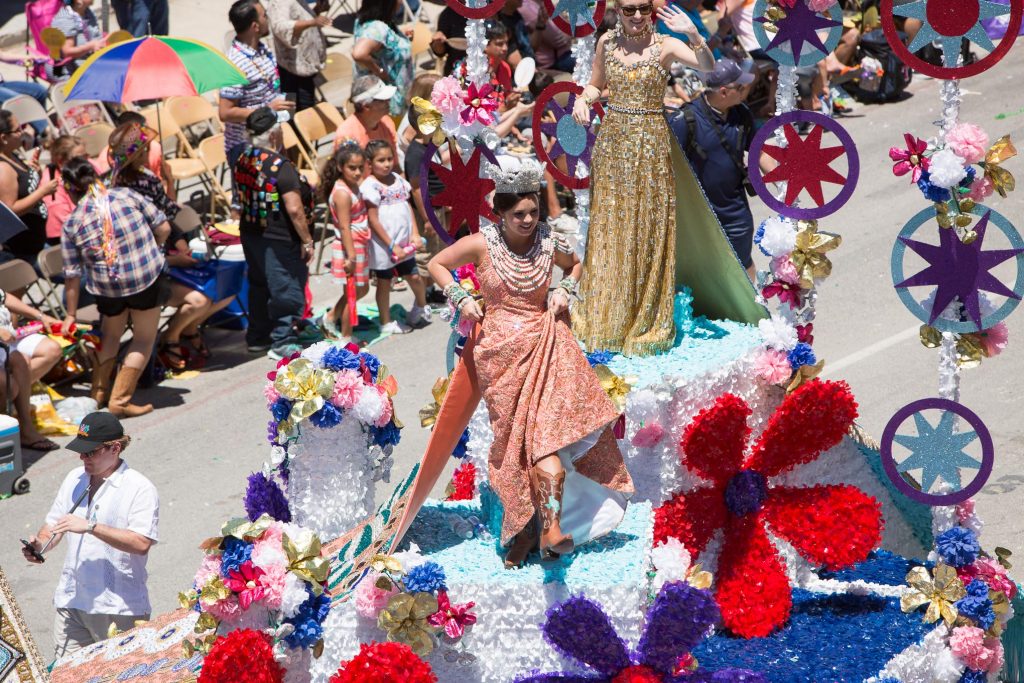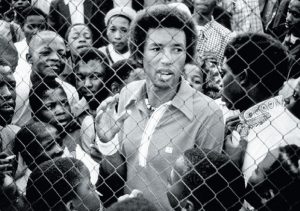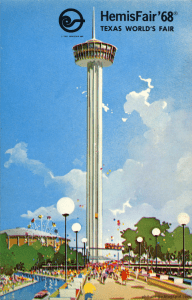Colorful floats; streets closed with barricades; people covering the sidewalks and setting up their lawn chairs to have a good view, having the day off from school; the Marching Bands from High Schools and Universities, decorating their instruments with ribbons, preparing their formation under Highway 37 on Grayson Street; the Fiesta Royalty putting on their best pairs of decorated shoes before stepping onto their throne, mounted on one of the biggest of the parade floats. If you’re a native San Antonian, you know exactly what grand celebration is about occur and what has been going on for the days before; it is part of Fiesta, the ten-day city-wide celebration; it is the Battle of Flowers parade. The Battle of Flowers is a 2.6-mile parade that runs through downtown San Antonio, typically one of the closing events of the Fiesta celebration. This Parades begins on the edge of downtown, and continues onto three major streets: Broadway, Alamo, and Commerce.1 Local schools participate in this parade; their dance troops, mariachi bands, ROTC, and Marching Band programs participate and walk the parade alongside the Texas Cavaliers, the Fiesta Royalty, and the Mayor. Although this annual event has become a hallmark for San Antonians, many don’t know how or when it all began. Let’s go back to its origins, back to the last decade of the nineteenth century in San Antonio.

Originating in 1891, the Battle of Flowers parade was created as a tribute to all those who fought and who fell at the Battles of San Jacinto and the Alamo.2 The idea of a grand celebration to commemorate these heroes came from a tourist, the native-Chicagoan W. J. Ballard. He believed that a proper tribute should be made, and asked a group of local ladies why this had not been the case just yet. His question extended through the city and made its way into newspapers and gained the approval of the community almost instantly. The anticipated idea aroused a spark of interest in Ellen Maury Slayden, a native Virginian elite, who had found her way to San Antonio by marriage to a merchant and later congressman, James L Slayden. Slayden then decided to bring Ballard’s idea to life, and since she knew it was almost impossible on her own, she decided to enlist the help of another newcomer to the area, J. S. Alexander. They both decided to take this on as a pet project of theirs, with the help and support of their husbands. Alexander, a banker before arriving in Texas, provided information on some familiarity he had had overseas about seeing a parade surrounded by flowers, where carts were decorated with flowers. Slayden also remembered similar instances in celebrations she knew about across Mexico and Spain, giving the basis for what the parade would become. The husbands, and many of the elite men of San Antonio, took over the project and had gentlemen speak on behalf of the ladies at the committee meetings; however, as the project grew, the ladies wanted to make sure that it was still a women’s project and continued to provide input and ideas, thus creating the Battle of Flowers Association.3

The parade was originally intended to be an April 21st celebration to celebrate the 55th anniversary of the victory of the Battle of San Jacinto; however, coincidentally, San Antonio was just then expecting its first-ever visit from the White House, the 23rd president of the United States, President Benjamin Harrison. As soon as word got out, the city became ecstatic and prepared a celebration to welcome the President, including moving the parade a day ahead of its original date. With the dates set in stone, the first official planning committee meeting took place only a mere seven days prior to the event. They were frantically trying to gather flowers from nearby towns, since San Antonio had just experienced some heavy rains, which had destroyed most flower gardens, leaving the city with a shortage of flowers just before the parade. Trains were rushed in with shipments of flowers from nearby towns. Other means of making up for the shortage were discussed as well, such as dressing the children up as flowers and having bicyclists decorate their mobiles with whatever blossoms they found and join the parade.4 In the days leading up to the parade, everything seemed all set to go, except for the weather. The city had been plagued with days of heavy rain, and the whole city was hopeful that the rains would cease as the day approached; however, they were wrong. On the morning of the parade, the rains didn’t have mercy on their plans, and as the President’s train arrived, the downpour became continuous. But the rains didn’t stop the city from providing the President with a warm welcome; however, it did postpone the flower parade for the following week, which, of course, would mean that the President would be long gone by then. When the warm weather finally arrived the following week, the parade went as planned; and it was so successful that the committee pushed to have it continue as an annual celebration. It has since been celebrated since 1891, except for the years during World Wars I and II.5

By 1985, the parade continued to grow into the week-long celebration known today as Fiesta. And as the years went by, Kings and Queens were elected as Fiesta Royalty.6 The Parade continues to grow, and so does its recognition across the city and the state. It is now funded by private associations. To this day the parade is one of the closing events of the city-wide, week-long Fiesta party and continues to generate community involvement. Every April, San Antonio puts on a fantastic show, and without a doubt, it all goes back to a Chicagoan tourist, two ladies, and one united community.

- Battle of Flowers, Official Website: Battle of Flowers About us (battleoflfowers.org, 2018). ↵
- Handbook of Texas, June 2010, s.v “Fiesta San Antonio,” by Mrs. Willard E. Simpson, Jr. ↵
- Jack Maguire, A Century of Fiesta in San Antonio (Austin, Texas: Eakin Press, 1990), 13-15. ↵
- Jack Maguire, A Century of Fiesta in San Antonio (Austin, Texas: Eakin Press, 1990), 17. ↵
- Jack Maguire, A Century of Fiesta in San Antonio (Austin, Texas: Eakin Press, 1990), 17; Laura Hernandez-Ehrisman, Inventing the Fiesta City, Heritage and Carnival in San Antonio (New Mexico Press,2008), 21. ↵
- Handbook of Texas, June 2010, s.v. “Fiesta San Antonio,” by Willard E. Simpson, Jr. ↵



117 comments
Auroara-Juhl Nikkels
I have lived in San Antonio for most of my life, but I have never attended the Battle of the Flowers parade. I knew the history behind it, but your article still provided some in depth details. San Antonio has such a deep and rich history that is much more than the Alamo that so many people automatically think of. One day, I hope to attend the parade they have. Good article!
Miranda Alamilla
Being born and raised in San Antonio, it’s not hard to see that San Antonians have pride in being from San Antonio. The Battle of the Flowers Parade is one of many things that makes San Antonio the city that it is. Since I was little, my grandma would reserve seats for the whole family and we would all come downtown to enjoy the festivities. Learning that this was a parade put together by women in the late 19th century just makes it so much better. Great article, I really enjoyed it!
Natalie Childs
Before this article, I hadn’t heard of the Battle of Flowers, so was interested to read it to learn more about the city. San Antonio has such rich history, and this event is truly an example of that. What I find most interesting is that the idea came from non natives that wanted to celebrate the culture and events that make San Antonio so important historically. I do wish the article would have discussed the significance of the shoes, especially since not being from here, I have absolutely no idea, but over all well done.
Samuel Stallcup
The Battle of Flowers has been something of note in my life ever since elementary school. We acted out the “battle,” and in high school I marched in the parade. Its amazing that the city is able to pull this event off every year and have so much success, even though it IS the same kind of party every year. I think that shows the Battle of Flowers is an important part of history for many people in San Antonio. Great article!
Maria Esquivel
I love San Antonio and its vibrant culture, it’s one of the main reasons I decided to attend school here. Reading your article about the Battle of Flowers makes me more excited about calling this incredible city home now. Overall, I found it really interesting how the parade originated and how it was moved up to welcome President Harrison to San Antonio. Learning about this event makes me really excited to attend these festivities one day. Great Job, Yahaira, I really enjoyed reading your article!
Hanadi Sonouper
This is such a great article, I love the historical meaning and background behind it, especially coming from a different city. San Antonio has such wonderful history, and it is riveting that they celebrate the battle at San Jacinto. The author did a great job at highlighting the history in order that helps the reader understand the meaning, where it originated, and who were the main characters. Overall it was an enjoyable read, and I look forward to seeing it come to life.
Matthew Wyatt
This article provides interesting background to an event I’ve attended virtually my entire life. I was a little disappointing, given the title of the article, that you didn’t explain the history of women in the parade being asked to show their shoes. From an editing perspective, there are several oddly structured sentences throughout the piece, some of them run-ons, which make the article hard to understand. Consider specifically rewriting the first paragraph. The multiple clauses and the use of both commas and semi-colons are needlessly confusing.